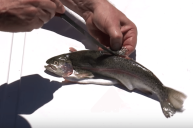"Anyone ever make a run with a hook in their face?" At least, one guy does, according to a new video shared by the social media channel Old Row Outdoors. The video shows a dude on a boat with a fishing hook stuck in his face, just below his lower lip.
While all the preliminary questions related to this video — who, where, what, why, and how— remain unanswered, what is known is that getting hooked in the face and other parts of the body happens sometimes. There are a variety of ways it can happen — while casting or negligence handling gear — but only two safe ways to remove it.
Oof pic.twitter.com/gMc3iqAFx6
— Old Row Outdoors (@OldRowOutdoors) June 1, 2024
How to remove a fishing hook from your face or body
If you search for how to remove a fishing hook, you'll find countless videos of people doing it on their own with a pair of pliers. And while it seems to work out for them, we prefer to share professional guidance. According to the federal National Library of Medicine, there are two ways to remove a fish hook stuck to your skin. These include the fish line method and the wire-cutting method.
Before you begin though, the NLM says you should wash your hands and the skin surrounding the hook. The agency also says you should see if the barb of the hook has entered the skin. If it has NOT, you should pull the tip of the hook out in the opposite direction than it went in. If it has, then you follow one of the two methods.
The agency also warns that if the hook is stuck deep into the skin, a joint, tendon, eye, eyelid, or artery, don't be stupid. Go to the hospital and let a medical professional take care of you.
Fish line method
- Put a fish line through the bend of the hook with enough slack that you can pull it straight backward, or directly in line with the hook's shaft.
- While holding the shaft, push the hook slightly downward and inward (away from the barb) to disengage the barb.
- Keeping constant pressure, quickly jerk the fish line so the hook pops out.
- Wash the wound and apply a bandage.
Wire cutting method
If the tip of the hook entered near the surface of the skin, push it up and through the skin. Then, cut it off just behind the barb with wire cutters. Lastly, remove the rest of the hook by pulling it back through the way it entered. Afterward, wash it thoroughly and apply a loose dressing with antibiotic ointment.
After removing the fish hook
When you do either method, the NLM explicitly says "do not close the wound with tape" because doing so could increase the chance of infection. Then, you should monitor the wound for signs of infection, such as redness, swelling, pain, and drainage. You should also make sure your tetanus immunization is up to date.
With all of this said, the NLM recommends three things to avoid and prepare for a fish hook injury. First, always practice safe fishing by keeping a safe distance between you and other people while you're handling a fishing rod. Second, make wire cutters and disinfectant solution part of your fishing gear. And, lastly, keep up to date on your tetanus immunization (you should get a shot every 10 years).




